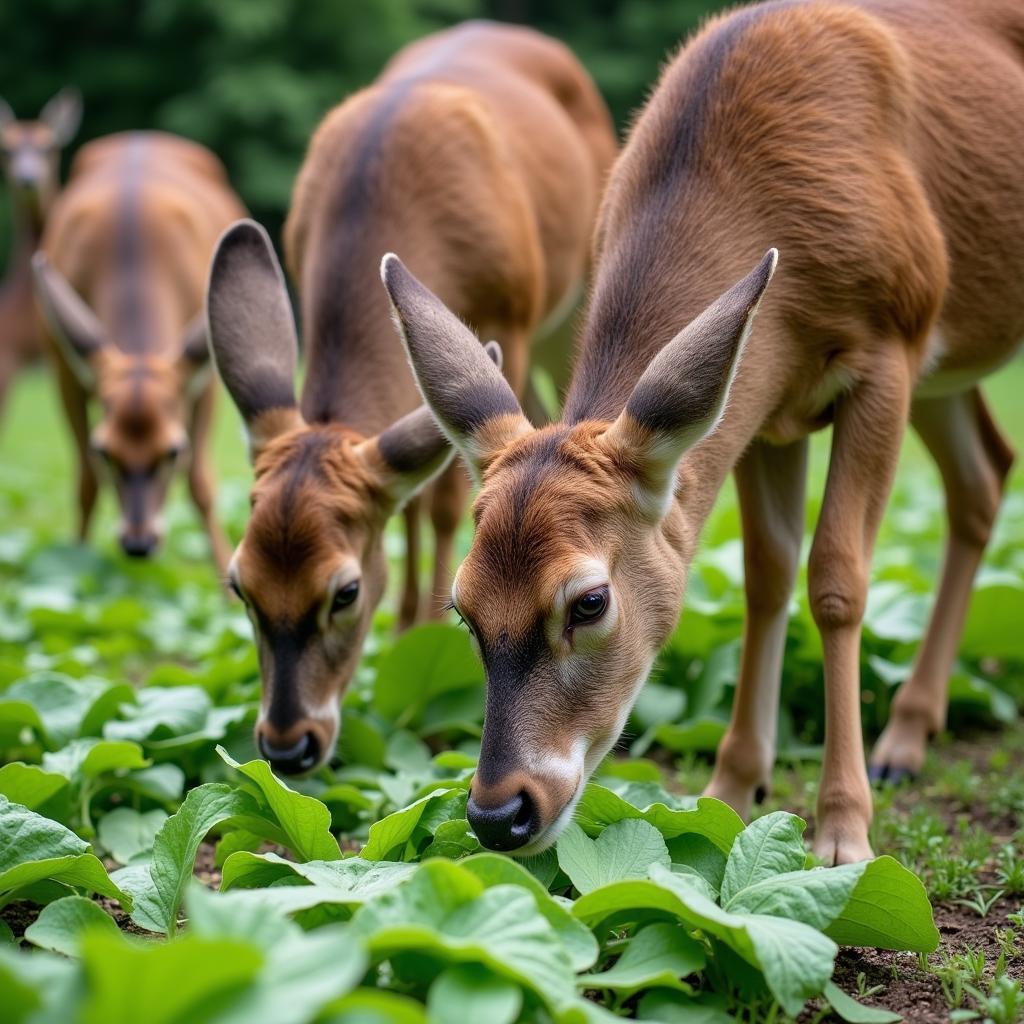Turnip Deer Food Plots are a popular choice for hunters and wildlife enthusiasts looking to attract deer to a specific area. They’re a relatively inexpensive and easy-to-grow brassica that provides a highly nutritious food source, especially during the fall and winter months when other forage options become scarce. But creating a successful turnip plot involves more than just scattering seeds. This guide will cover everything you need to know, from soil preparation to planting and maintenance, to help you create a thriving turnip food plot that deer will love.
Planting a food plot for deer with turnips provides essential nutrients for healthy herd development. Proper planning and execution are key to maximizing the benefits of your turnip deer food plots. Factors like soil type, planting time, and maintenance practices all play a crucial role in the success of your plot. Let’s delve into the details to ensure your turnip plot is a magnet for deer. Choosing turnips for your deer food plot can offer a high-yield, nutritious food source that attracts deer throughout the hunting season and beyond. Understanding the nuances of planting and maintaining these plots is crucial for their success.
Choosing the Right Turnip Variety for Your Deer Food Plot
Selecting the right turnip variety is the first step towards a successful food plot. Consider factors such as your local climate, soil conditions, and the specific needs of the deer in your area. Some popular varieties include Purple Top White Globe, Alamo, and Appin. These varieties are known for their cold hardiness, high nutritional value, and palatability to deer. For those interested in other options, consider exploring resources on seed for food plot.
Soil Preparation for Turnip Deer Food Plots
Proper soil preparation is essential for healthy turnip growth. Test your soil pH and amend it as necessary. Turnips prefer a slightly acidic soil with a pH between 6.0 and 6.5. Incorporate organic matter, such as compost or well-rotted manure, to improve soil fertility and drainage. This helps establish strong root systems, essential for nutrient uptake and overall plant health. A well-prepared seedbed ensures good seed-to-soil contact, promoting germination and robust growth.
Planting Your Turnip Deer Food Plot
The best time to plant turnips for deer is late summer or early fall, ideally 6-8 weeks before the first frost. This allows the turnips to establish themselves before the colder weather sets in. Broadcast the seeds evenly over the prepared soil and lightly rake them in. Aim for a seeding rate of about 4-5 pounds per acre. Ensure adequate spacing between seeds for optimal growth and to prevent overcrowding.
Maintaining Your Turnip Deer Food Plot
Once your turnips are established, regular maintenance is crucial. Keep the plot weed-free to minimize competition for resources. You can achieve this through hand-weeding, cultivation, or by using a selective herbicide. Consider a deer food plot turnips specific guide for more detailed maintenance tips.
 Maintaining a healthy turnip food plot for deer
Maintaining a healthy turnip food plot for deer
Maximizing Your Turnip Deer Food Plot Success
To further enhance your turnip deer food plot, consider planting a mix of brassicas, such as radishes, kale, or rape. This provides a diverse food source and can attract deer throughout the season. For shaded areas, adapt your planting strategy by choosing shade-tolerant species. Find more information on how to manage food plot shaded areas. Additionally, strategically placing your turnip plot near a late season deer food plot with different forage options can ensure a consistent food supply for the deer.
Do deer prefer turnips over other food plot options?
While deer enjoy turnips, their preference can vary depending on available forage. Offering diverse food plot options like an oats food plot can increase the attractiveness of your overall hunting area.
“A diverse food plot is crucial for a healthy deer herd. Turnips provide an excellent fall and winter food source, but incorporating other plants ensures a well-rounded diet throughout the year,” says Dr. Emily Carter, Wildlife Biologist.
Conclusion
Turnip deer food plots are a valuable tool for attracting and providing for deer. By following the steps outlined in this guide, you can create a successful plot that will attract deer and contribute to their overall health. Remember, the key to a thriving turnip food plot lies in proper planning, soil preparation, planting techniques, and consistent maintenance. So, get your hands dirty and start planting your turnip deer food plot today!
FAQ
- When should I plant turnips for deer? Late summer or early fall, 6-8 weeks before the first frost.
- How much seed should I use for my turnip food plot? 4-5 pounds per acre.
- What is the ideal soil pH for turnips? 6.0-6.5.
- How do I maintain my turnip deer food plot? Keep it weed-free through regular weeding or herbicides.
- What other plants can I include in my deer food plot? Radishes, kale, and rape are good companions for turnips.
- Are turnips a good late-season food source for deer? Yes, turnips provide excellent nutrition during the fall and winter months.
- What are some common turnip varieties for deer plots? Purple Top White Globe, Alamo, and Appin.
 Deer grazing in a turnip food plot
Deer grazing in a turnip food plot
“Providing high-quality forage like turnips is an investment in the health and well-being of the local deer population,” advises John Miller, Experienced Hunter and Outdoorsman.
Need more help? Contact us at Phone Number: 02437655121, Email: minacones@gmail.com Or visit our address: 3PGH+8R9, ĐT70A, thôn Trung, Bắc Từ Liêm, Hà Nội, Việt Nam. We have a 24/7 customer support team.